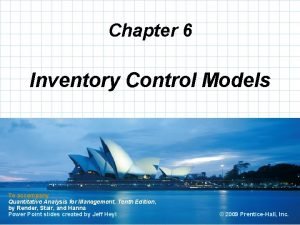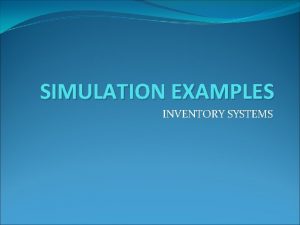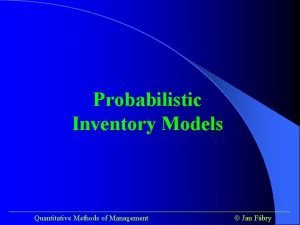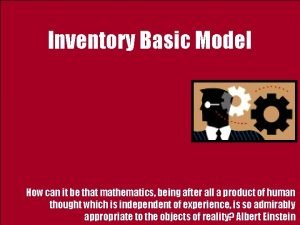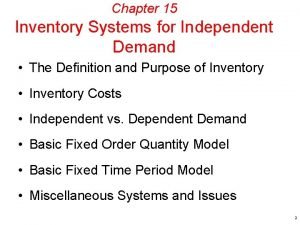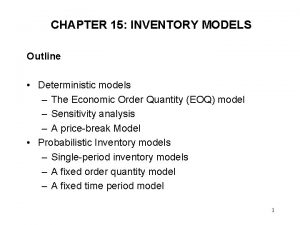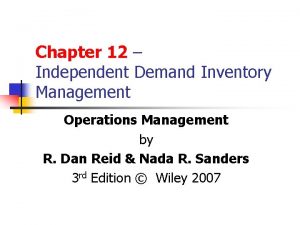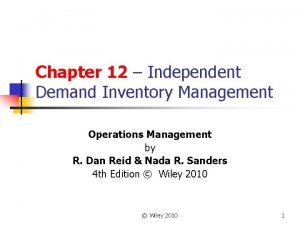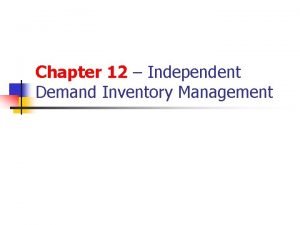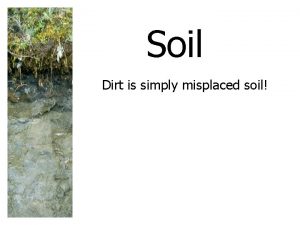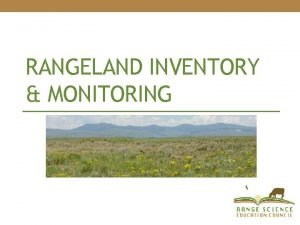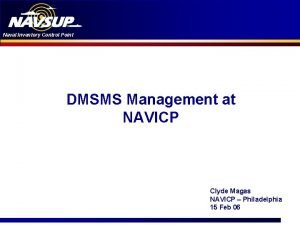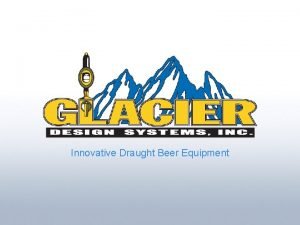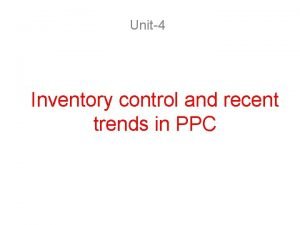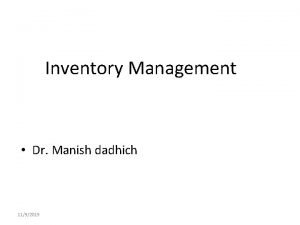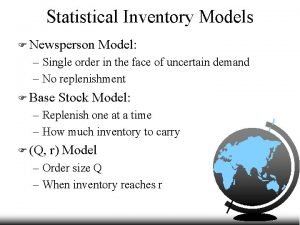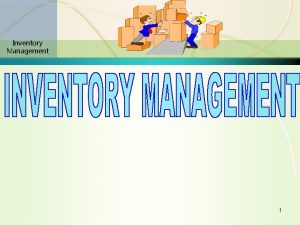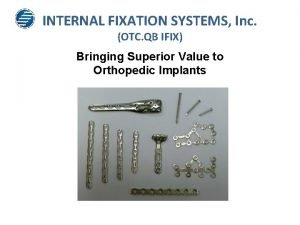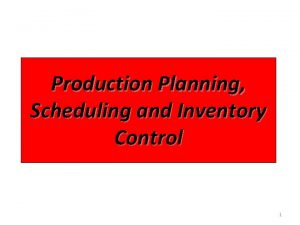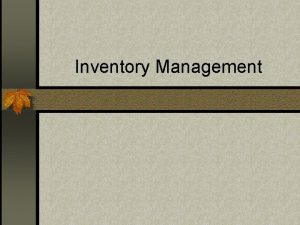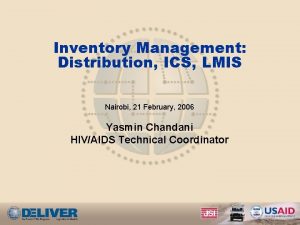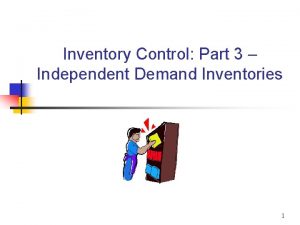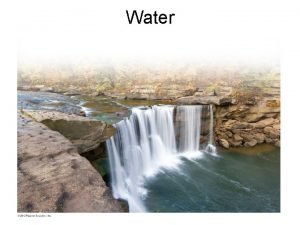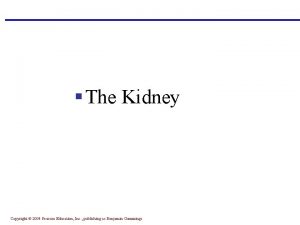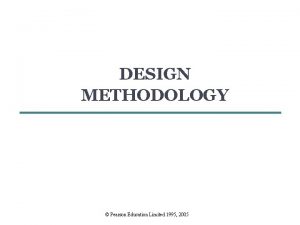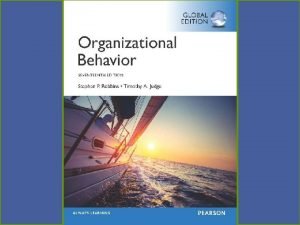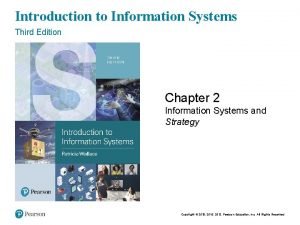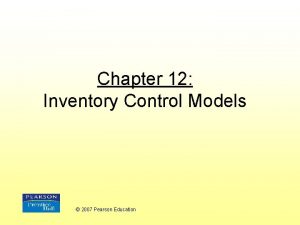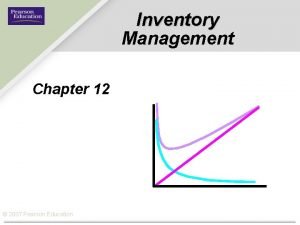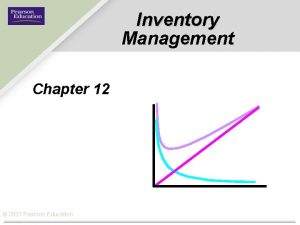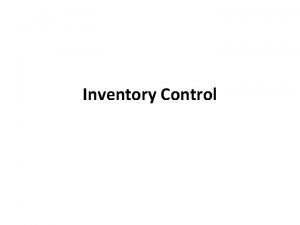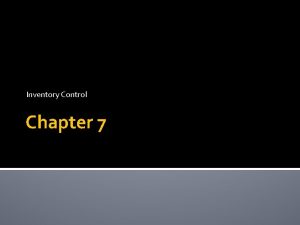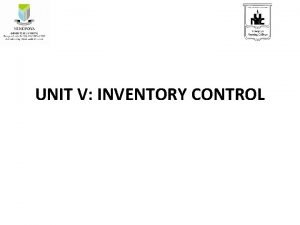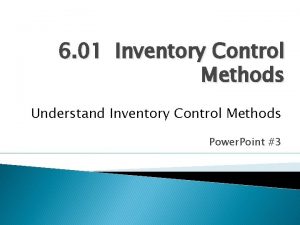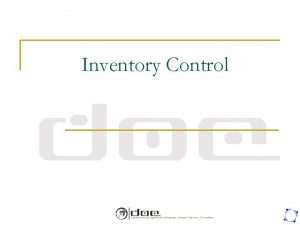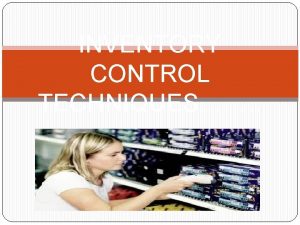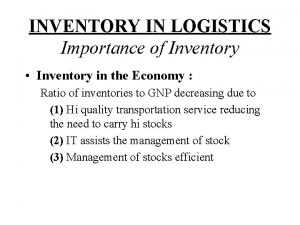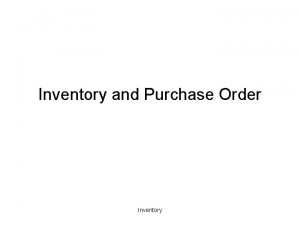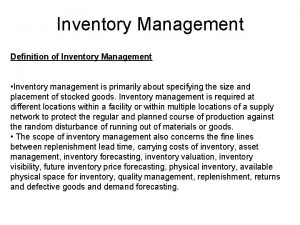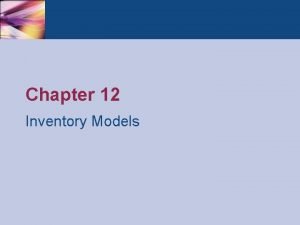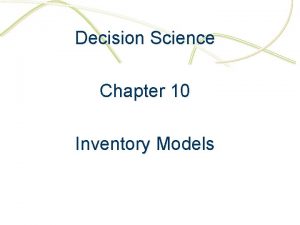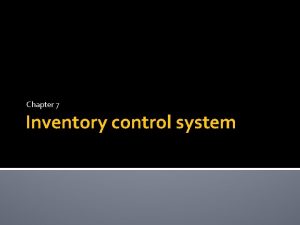Chapter 12 Inventory Control Models 2007 Pearson Education



















































- Slides: 51

Chapter 12: Inventory Control Models © 2007 Pearson Education

Inventory • Any stored resource used to satisfy a current or future need (raw materials, work -in-process, finished goods, etc. ) • Represents as much as 50% of invested capitol at some companies • Excessive inventory levels are costly • Insufficient inventory levels lead to stockouts

Inventory Planning and Control For maintaining the right balance between high and low inventory to minimize cost

Main Uses of Inventory 1. 2. 3. 4. 5. The decoupling function Storing resources Irregular supply and demand Quantity discounts Avoiding stockouts and shortages

Inventory Control Decisions Objective: Minimize total inventory cost Decisions: • How much to order? • When to order?

Components of Total Cost 1. 2. 3. 4. 5. Cost of items Cost of ordering Cost of carrying or holding inventory Cost of stockouts Cost of safety stock (extra inventory held to help avoid stockouts)

Economic Order Quantity (EOQ): Determining How Much to Order • One of the oldest and most well known inventory control techniques • Easy to use • Based on a number of assumptions

Assumptions of the EOQ Model 1. 2. 3. 4. 5. Demand is known and constant Lead time is known and constant Receipt of inventory is instantaneous Quantity discounts are not available Variable costs are limited to: ordering cost and carrying (or holding) cost 6. If orders are placed at the right time, stockouts can be avoided

Inventory Level Over Time Based on EOQ Assumptions

Minimizing EOQ Model Costs • Only ordering and carrying costs need to be minimized (all other costs are assumed constant) • As Q (order quantity) increases: – Carry cost increases – Ordering cost decreases (since the number of orders per year decreases)

EOQ Model Total Cost At optimal order quantity (Q*): Carrying cost = Ordering cost

Finding the Optimal Order Quantity Parameters: Q* = Optimal order quantity (the EOQ) D = Annual demand Co = Ordering cost per order Ch = Carrying (or holding) cost per unit per yr P = Purchase cost per unit

Two Methods for Carrying Cost Carry cost (Ch) can be expressed either: 1. As a fixed cost, such as Ch = $0. 50 per unit per year 2. As a percentage of the item’s purchase cost (P) Ch = I x P I = a percentage of the purchase cost

EOQ Total Cost Total ordering cost = (D/Q) x Co Total carrying cost = (Q/2) x Ch Total purchase cost =Px. D = Total cost Note: • (Q/2) is the average inventory level • Purchase cost does not depend on Q

Finding Q* Recall that at the optimal order quantity (Q*): Carry cost = Ordering cost (D/Q*) x Co = (Q*/2) x Ch Rearranging to solve for Q*: Q* =

EOQ Example: Sumco Pump Co. Buys pump housing from a manufacturer and sells to retailers D Co Ch P = 1000 pumps annually = $10 per order = $0. 50 per pump per year = $5 Q* = ?

Using Excel. Modules for Inventory • Worksheet for inventory models in Excel. Modules are color coded – Input cells are yellow – Output cells are green • Select “Inventory Models” from the Excel. Modules menu, then select “EOQ” Go to file 12 -2. xls

Average Inventory Value After Q* is found we can calculate the average value of inventory on hand Average inventory value = P x (Q*/2)

Calculating Ordering and Carrying Costs for a Given Q • Sometimes Co and Ch are difficult to estimate • We can use the EOQ formula to calculate the value of Co or Ch that would make a given Q optimal: Co = Q 2 x Ch/(2 D) Ch = 2 DCo/Q 2

Sensitivity of the EOQ Formula • The EOQ formula assumes all inputs are know with certainty • In reality these values are often estimates • Determining the effect of input value changes on Q* is called sensitivity analysis

Sensitivity Analysis for Sumco • Suppose Co = $15 (instead of $10), which is a 50% increase • Assume all other values are unchanged • The new Q* = 245 (instead of 200), which is a 22. 5% increase • This shows the nonlinear nature of the formula

Reorder Point: Determining When to Order • After Q* is determined, the second decision is when to order • Orders must usually be placed before inventory reaches 0 due to order lead time • Lead time is the time from placing the order until it is received • The reorder point (ROP) depends on the lead time (L)

Reorder Point (ROP) ROP = d x L

Sumco Example Revisited • Assume lead time, L = 3 business days • Assume 250 business days per year • Then daily demand, d = 1000 pumps/250 days = 4 pumps per day ROP = (4 pumps per day) x (3 days) = 12 pumps Go to file 12 -3. xls

Economic Production Quantity: Determining How Much to Produce • The EOQ model assumes inventory arrives instantaneously • In many cases inventory arrives gradually • The economic production quantity (EPQ) model assumes inventory is being produced at a rate of p units per day • There is a setup cost each time production begins

Inventory Control With Production

Determining Lot Size or EPQ Parameters Q* = Optimal production quantity (or EPQ) Cs = Setup cost D = annual demand d = daily demand rate p = daily production rate

Average Inventory Level • We will need the average inventory level for finding carrying cost • Average inventory level is ½ the maximum Max inventory = Q x (1 - d/p) Ave inventory = ½ Q x (1 - d/p)

Total Cost Setup cost Carrying cost Production cost = Total cost = (D/Q) x Cs = [½ Q x (1 - d/p)] x Ch =Px. D As in the EOQ model: • The production cost does not depend on Q • The function is nonlinear

Finding Q* • As in the EOQ model, at the optimal quantity Q* we should have: Setup cost = Carrying cost (D/Q*) x Cs = [½ Q* x (1 - d/p)] x Ch Rearranging to solve for Q*: Q* =

EPQ for Brown Manufacturing Produces mini refrigerators (has 167 business days per year) D = 10, 000 units annually d = 1000 / 167 = ~60 units per day p = 80 units per day (when producing) Ch = $0. 50 per unit per year Cs = $100 per setup P = $5 to produce each unit Go to file 12 -4. xls

Length of the Production Cycle • The production cycle will last until Q* units have been produced • Producing at a rate of p units per day means that it will last (Q*/p) days • For Brown this is: Q* = 4000 units p = 80 units per day 4000 / 80 = 50 days

Quantity Discount Models • A quantity discount is a reduced unit price based on purchasing a large quantity • Example discount schedule:

Four Steps to Analyze Quantity Discount Models 1. Calculate Q* for each discount price 2. If Q* is too small to qualify for that price, adjust Q* upward 3. Calculate total cost for each Q* 4. Select the Q* with the lowest total cost

Brass Department Store Example Sells toy cars D = 5000 cars annually Co = $49 per order Ch = $0. 20 per car per year Quantity Discount Schedule go to file 12 -5. xls

Use of Safety Stock • Safety stock (SS) is extra inventory held to help prevent stockouts • Frequently demand is subject to random variability (uncertainty) • If demand is unusually high during lead time, a stockout will occur if there is no safety stock

Use of Safety Stock

Determining Safety Stock Level Need to know: • Probability of demand during lead time (DDLT) • Cost of a stockout (includes all costs directly or indirectly associated, such as cost of a lost sale and future lost sales)

ABCO Safety Stock Example • • • ROP = 50 units (from previous EOQ) Place 6 orders per year Stockout cost per unit = $40 Ch = $5 per unit per year DDLT has a discrete distribution

Analyzing the Alternatives • With uncertain DDLT this becomes a “decision making under risk” problem • Each of the five possible values of DDLT represents a decision alternative for ROP • Need to determine the economic payoff for each combination of decision alternative (ROP) and outcome (DDLT)

Stockout and Additional Carrying Costs Stockout Cost Additional Carrying Cost ROP = DDLT 0 0 ROP < DDLT $40 per unit short per year 0 0 $5 per unit per year ROP > DDLT Go to file 12 -6. xls

Safety Stock With Unknown Stockout Costs • Determining stockout costs may be difficult or impossible • Customer dissatisfaction and possible future lost sales are difficult to estimate • Can use service level instead Service level = 1 – probability of a stockout

Hinsdale Co. Example • DDLT follows a normal distribution (μ = 350, σ = 10) • They want a 95% service level (i. e. 5% probability of a stockout) SS = ?

Safety Stock and the Normal Distribution

Calculating SS From the standard Normal Table, Z = 1. 645 = X – 350 10 so X= 366. 45 and, SS = 16. 45 (which could be rounded to 17)

Hinsdale’s Carrying Cost • Assume Hinsdale has a carrying cost of $1 per unit per year • We can calculate the SS and its carrying cost for various service levels

Cost of Different Service Levels

Carrying Cost Versus Service Level Go to file 12 -7. xls

ABC Analysis • Recognizes that some inventory items are more important than others • A group items are considered critical (often about 70% of dollar value and 10% of items) • B group items are important but not critical (often about 20% of dollar value and 20% of items) • C group items are not as important (often about 10% of dollar value and 70% of items)

Silicon Chips Inc. Example • Maker of super fast DRAM chips • Has 10 inventory items • Wants to classify them into A, B, and C groups • Calculate dollar value of each item and rank items

Inventory Items for Silicon Chips Go to file 12 -8. xls
 Inventory control models
Inventory control models 2011 pearson education inc
2011 pearson education inc Pearson education inc publishing as pearson prentice hall
Pearson education inc publishing as pearson prentice hall Pearson education inc publishing as pearson prentice hall
Pearson education inc publishing as pearson prentice hall Pearson education inc publishing as pearson prentice hall
Pearson education inc publishing as pearson prentice hall 2008 pearson prentice hall inc
2008 pearson prentice hall inc Inventory simulation examples
Inventory simulation examples Probabilistic inventory models example
Probabilistic inventory models example Most inventory models attempt to minimize
Most inventory models attempt to minimize Dependent demand items
Dependent demand items Deterministic demand vs stochastic demand
Deterministic demand vs stochastic demand Independent inventory
Independent inventory Deterministic and probabilistic inventory models
Deterministic and probabilistic inventory models Inventory models for independent demand
Inventory models for independent demand Independent demand
Independent demand Deterministic and stochastic inventory models
Deterministic and stochastic inventory models Independent demand inventory system
Independent demand inventory system Robert whelan
Robert whelan Stress management for life 5th edition
Stress management for life 5th edition What is the difference between semi modals and modals?
What is the difference between semi modals and modals? Mitochondria
Mitochondria Simply misplaced
Simply misplaced Smart goals for inventory control
Smart goals for inventory control Functions of inventory
Functions of inventory Inventory control definition
Inventory control definition Dmsms navy
Dmsms navy Draft beer inventory control
Draft beer inventory control What is inventory in ppc
What is inventory in ppc Sos analysis
Sos analysis Eyeball system inventory control
Eyeball system inventory control Statistical inventory control
Statistical inventory control Inventory management objectives
Inventory management objectives Synthes mini frag inventory control
Synthes mini frag inventory control Inventory management and production planning and scheduling
Inventory management and production planning and scheduling Storage and inventory control in operation plan example
Storage and inventory control in operation plan example Lmis kemsa
Lmis kemsa Independent demand meaning
Independent demand meaning Water cycle pearson education
Water cycle pearson education 2004 pearson education benjamin cummings
2004 pearson education benjamin cummings Pearson education limited 2008
Pearson education limited 2008 Carbon cycle pearson education
Carbon cycle pearson education Pearson education limited 2005
Pearson education limited 2005 2018 pearson education inc
2018 pearson education inc Pearson education ltd
Pearson education ltd Pearson education ltd
Pearson education ltd Copyright by pearson education inc. answers
Copyright by pearson education inc. answers 2017 pearson education inc
2017 pearson education inc 2017 pearson education inc
2017 pearson education inc 2017 pearson education inc
2017 pearson education inc 2017 pearson education inc
2017 pearson education inc 2016 pearson education inc
2016 pearson education inc 2015 pearson education inc
2015 pearson education inc
